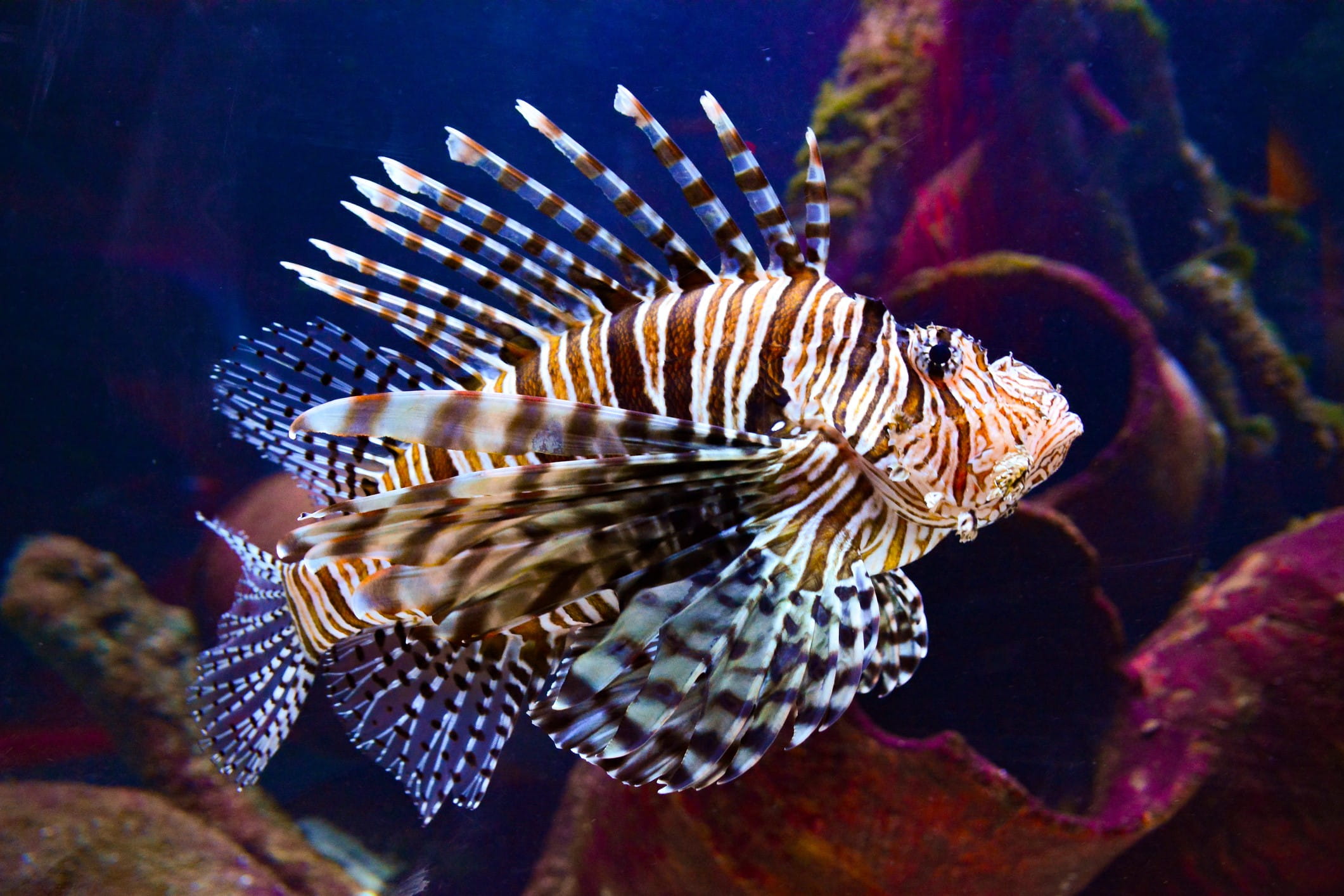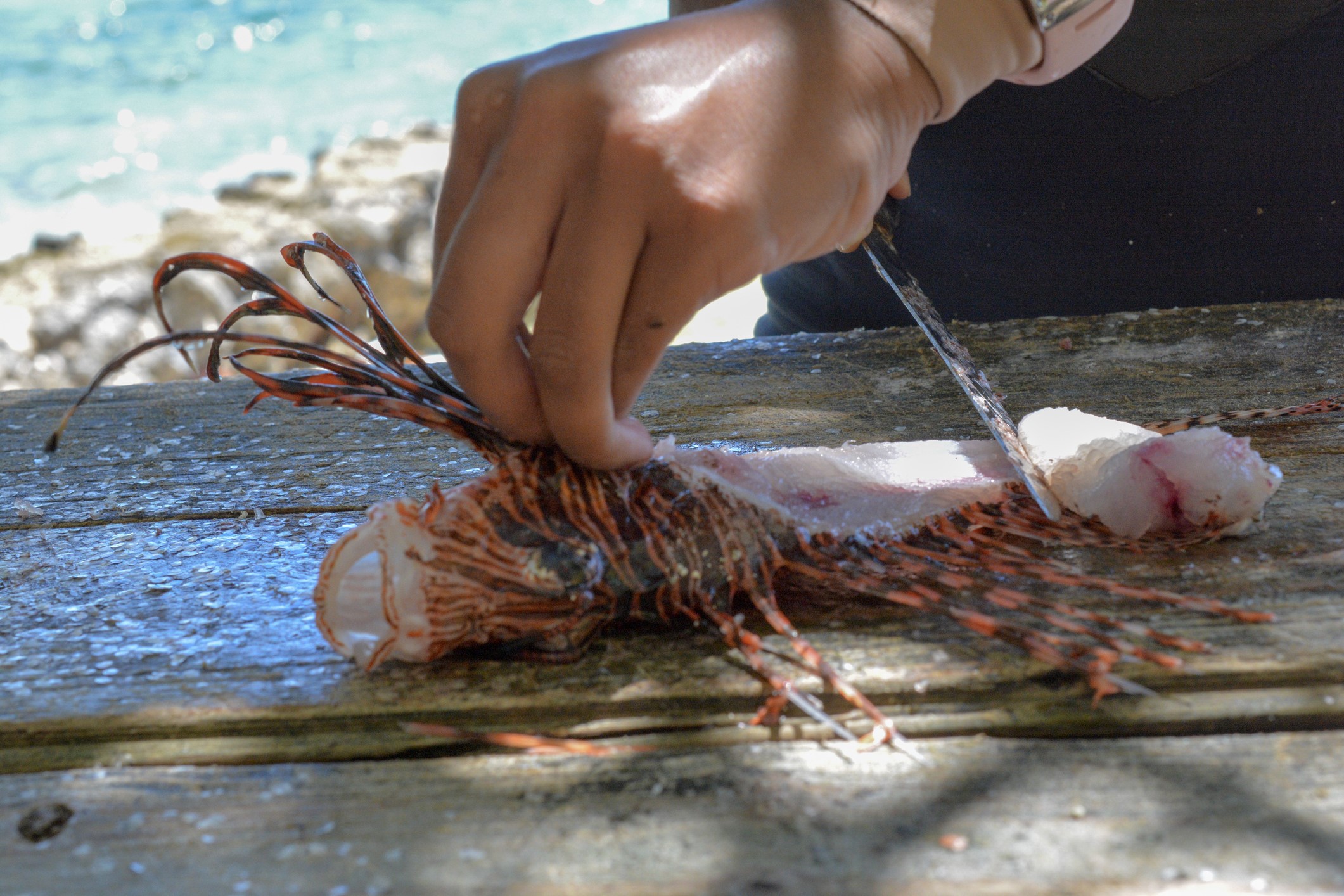How to Treat a Lionfish Sting

The Bottom Line
Lionfish are invasive, meat-eating fish that reproduce quickly. They have spread to non-native waters and can quickly destroy reef ecosystems. They have defensive spines on the top and bottom of their bodies that can cause painful stings. Symptoms following lionfish stings can include swelling, tenderness, redness, sweating, and muscle weakness.

Lionfish look delicate as they use their fan-like fins to gently move through the ocean, but don't be fooled by this flamboyant fish. They are an invasive, meat-eating species that reproduces quickly. A female lionfish can release up to 2 million eggs a year. While they are native to the South Pacific and Indian Oceans, they have spread rapidly into the North Atlantic, including the Gulf of Mexico and Caribbean Sea. They are popular aquarium fish, and it is thought that owners releasing their lionfish into the wild have facilitated their spread to non-native waters. Lionfish have big appetites and have no natural predators in Atlantic waters. When they arrive at a coral reef, they can eat so much that they reduce the local fish population by as much as 70%. The National Oceanic and Atmospheric Administration has launched a campaign urging people to eat lionfish to help reduce their numbers. However, the Food and Drug Administration warns that lionfish can contain a toxin known as ciguatera. Ciguatera toxin is heat stable and cooking does not remove the toxin from the meat. There is no specific prevention when it comes to ciguatera exposure; however, eating fish smaller than about 4-6 pounds reduces the risk. The average lionfish weighs approximately 1-2 pounds. Properly prepared lionfish is supposed to be pretty tasty!
The majority of calls made to Poison Control about lionfish involve stings. Although lionfish stings are very painful, most can be managed at home if pain is controlled and tetanus immunization is up to date. Symptoms following lionfish stings develop within minutes to a few hours and can include swelling, tenderness, warm skin directly surrounding the sting site, redness, sweating, muscle weakness, and a tingling sensation. A lionfish sting involving multiple spines increases the risk of infection and body-wide symptoms such as changes in heart rate, abdominal pain, sweating, and fainting. Deaths from lionfish stings are rare. Symptoms can last anywhere from 8 hours to 30 days depending on the severity of the sting.
If you are stung by a lionfish, here are some first-aid steps:
- Wearing gloves and using tweezers, carefully remove spines from the wound, trying not to squeeze the venom glands.
- Wash the area with soap and water.
- Soak the affected limb in water hot enough to tolerate but not to burn, or take a hot shower for 10–20 minutes. An adult should test the water to make sure it is not scalding hot for children.
- Use over-the-counter medication to treat pain.
- Call your doctor or pharmacist to make sure your tetanus immunization is up to date.
- An x-ray might be needed to ensure that there are no broken spines left in the sting site.
Visit an urgent care center or emergency room if you experience any of the following:
- severe muscle aches or cramps.
- severe or persistent pain at sting site.
- feeling faint.
- evidence of infection such as fever, expanding redness, swelling, or pus.
- paralysis.
- spines still visible in the wound after attempts to remove them.
If you suspect someone has been stung by a lionfish and is experiencing symptoms, check the webPOISONCONTROL® online tool for guidance or call Poison Control at 1-800-222-1222.
Lindsy Liu, PharmD
Certified Specialist in Poison Information
Poisoned?
Call 1-800-222-1222 or
Prevention Tips
- For those who keep lionfish as pets, be aware of their location while cleaning the tank, wear gloves, and keep your hands well away from their spines.
- Avoid touching or handling lionfish. Even a dead lionfish can sting!
- Wear protective clothing if you plan to swim or dive in infested areas.
- Never return a live lionfish to the ocean.
This Really Happened
Case 1. A 62-year-old woman was stung on her finger by her dwarf lionfish while she was cleaning its aquarium. The finger immediately developed a bruise, became swollen, and there was pain at the sting site. She was instructed to soak her finger in tolerably hot water and to use over-the-counter pain medications. She was encouraged to see a medical provider to ensure that no spines were stuck in her finger and to get an updated tetanus vaccination. By the next day all of her symptoms had resolved.
Case 2. A 57-year-old man put too much fish food into an aquarium at his workplace. He was stung by a lionfish when he reached into the tank to remove the excess food. The finger was red and swollen, and there was some bleeding at the sting site. He was instructed to soak his hand in tolerably hot water. In an emergency room, he was given opioid medication to control his pain. He was started on antibiotics and allowed to go home; his tetanus vaccination was already up to date. Four days later, his symptoms had resolved.For More Information
Lanese, N. Lionfish: Beautiful and Dangerous Invaders. Live Science [cited 2021 08 30].
Lionfish sting first aid and treatment. Lionfish.co [cited 2020 Mar 9].
Lionfish sting. Champaign (IL): DoveMed; updated 2018 Oct 29 [cited 2020 Mar 9].
References
Garyfallou GT, Madden JF. Lionfish envenomation. Ann Emerg Med. 1996 Oct;28(4):456-7.
Hobday D, Chadha P, Din AH, Geh J. Denaturing the lionfish. Eplasty. 2016 May 23;16:ic20.
Vetrano SJ, Lebowitz JB, Marcus S. Lionfish envenomation. J Emerg Med. 2002 Nov;23(4):379-82.
Poisoned?
Call 1-800-222-1222 or
Prevention Tips
- For those who keep lionfish as pets, be aware of their location while cleaning the tank, wear gloves, and keep your hands well away from their spines.
- Avoid touching or handling lionfish. Even a dead lionfish can sting!
- Wear protective clothing if you plan to swim or dive in infested areas.
- Never return a live lionfish to the ocean.
This Really Happened
Case 1. A 62-year-old woman was stung on her finger by her dwarf lionfish while she was cleaning its aquarium. The finger immediately developed a bruise, became swollen, and there was pain at the sting site. She was instructed to soak her finger in tolerably hot water and to use over-the-counter pain medications. She was encouraged to see a medical provider to ensure that no spines were stuck in her finger and to get an updated tetanus vaccination. By the next day all of her symptoms had resolved.
Case 2. A 57-year-old man put too much fish food into an aquarium at his workplace. He was stung by a lionfish when he reached into the tank to remove the excess food. The finger was red and swollen, and there was some bleeding at the sting site. He was instructed to soak his hand in tolerably hot water. In an emergency room, he was given opioid medication to control his pain. He was started on antibiotics and allowed to go home; his tetanus vaccination was already up to date. Four days later, his symptoms had resolved.